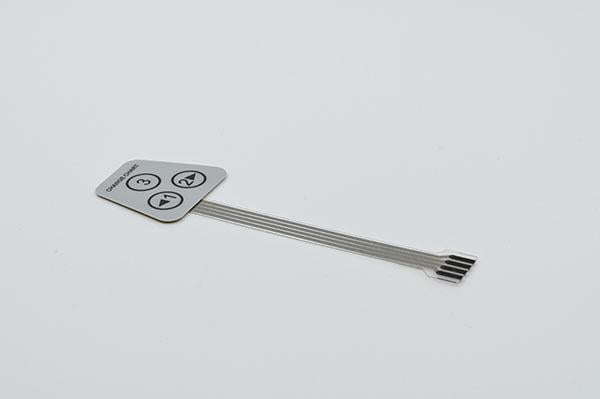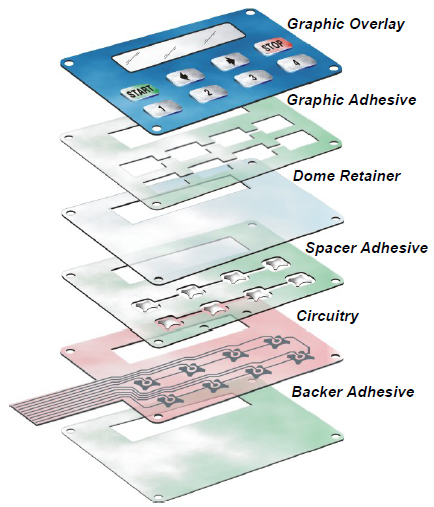All Regarding Membrane Switch Over: Comprehending Its Design and Capability
When you think of the control user interfaces in contemporary tools, membrane layer switches usually come to mind. These parts are greater than just switches; they blend style and functionality flawlessly. Recognizing how they function and what makes them reliable can alter your viewpoint on daily electronic devices. There are nuances to their style and efficiency that you might not be mindful of. Let's explore what collections membrane changes in addition to other control systems.
What Are Membrane Layer Switches?

Their smooth nature makes them easy to clean and resistant to dirt and moisture, an important attribute in lots of environments. Membrane buttons can additionally be personalized concerning form, size, and graphics, permitting manufacturers to create special user interfaces tailored to specific items. Plus, they're light-weight and thin, which aids in minimizing the total mass of devices. In general, membrane layer switches play a considerable duty in improving customer experience across a wide selection of applications.
How Membrane Switches Over Work
When you push a trick on a membrane button, it triggers an uncomplicated yet effective system. membrane switch manufacturer. The top layer, commonly made of flexible product, presses down onto a conductive layer beneath it.
You'll discover that the tactile responses varies based on the button style, offering either a soft click or a much more pronounced action. As soon as you release the secret, the membrane go back to its original setting, reopening the circuit and stopping the signal. This procedure takes place practically instantly, guaranteeing a responsive user experience.
Membrane buttons are preferred due to their toughness and resistance to dust and dampness, making them perfect for numerous applications, from home home appliances to clinical tools. Recognizing this operation helps you appreciate their extensive use.
Secret Parts of Membrane Layer Buttons
Recognizing the vital components of membrane switches is basic for grasping their performance and layout. At the core, you'll locate the visuals overlay, which provides the visual interface for individuals. Underneath that, there's a spacer layer that divides the circuit layers, making certain that they do not make contact until pushed. The circuit layer is where the magic occurs; it contains conductive traces that complete the circuit when you press the switch. An additional important aspect is the adhesive support, permitting the button to follow surfaces securely. Ultimately, the safety layer guards against environmental factors and put on, expanding the button's life expectancy. Each element plays a considerable role in guaranteeing reputable performance and user interaction. By understanding these parts, you'll gain insight into how membrane switches run and their relevance in different applications.
Materials Used in Membrane Switch Layout
The performance and longevity of membrane layer switches heavily depend on the materials utilized in their style. You typically encounter polyester and polycarbonate as key substratums because of their excellent stamina and adaptability. These materials stand up to scrapes and chemicals, making them suitable for demanding settings.
The conductive layers commonly use silver or carbon, chosen for their reliability and conductivity. membrane switch manufacturer. Silver offers click this site superior performance, while carbon is a cost-effective alternative. For the overlay, you may take into consideration a matte or glossy surface, relying on your visual needs and user experience
Adhesives play a crucial role too; they bond layers safely and ensure durability. Make particular to pick adhesives that withstand ecological variables like temperature level and moisture. Ultimately, don't ignore the relevance of an excellent printing strategy for graphics, as it boosts both capability and aesthetic allure. Selecting the ideal products will guarantee your membrane button stands the examination of time.
Design Considerations for Membrane Switches
While designing membrane layer buttons, it's important to take into consideration various elements that affect their functionality and individual experience. Start by concentrating on the format and button dimension; make specific they're intuitive and simple to browse. Think about the tactile responses you intend to provide-- will customers need a recognizable click or a softer touch? In addition, he has a good point think of the products you'll utilize, as they'll influence durability and appearances.
Confirm your design accommodates environmental factors, like moisture or temperature variations, which could influence performance. By meticulously considering these elements, you'll develop a membrane layer switch that enhances functionality and complete satisfaction.
Applications of Membrane Buttons
Membrane layer switches are versatile components located in numerous applications, from industrial equipment to consumer electronics. You'll see their influence in devices that need resilient interfaces and in gadgets that gain from streamlined styles. Understanding these applications aids you value the performance and usefulness of membrane buttons in daily technology.
Industrial Tools Use
When you're looking to improve the capability of commercial equipment, membrane switches use a reliable service that integrates toughness with user-friendly layout. These buttons are perfect for extreme settings, providing resistance to dust, moisture, and chemicals. Embrace membrane switches to improve your operations and enhance general efficiency.
Customer Electronic Devices Assimilation
In the domain name of customer electronic devices, membrane buttons play a vital duty in boosting customer communication and tool functionality. You'll discover them in tools like microwaves, remotes, and video gaming consoles, supplying a smooth method to communicate with technology. Their sleek design permits very easy integration right into numerous items, making controls user-friendly and easy to use. With their capability to incorporate graphics and backlighting, you can delight in a modern-day visual that matches the device's general appearance. Membrane layer buttons also guarantee durability and resistance to dirt and dampness, prolonging the life expectancy of your electronics. By choosing membrane switches, you improve not simply the performance however likewise the design of your tools, making day-to-day communications smooth and pleasurable.
Benefits and Disadvantages of Membrane Buttons
While membrane layer buttons provide a variety of benefits, they also include some disadvantages that you must consider. One substantial benefit is their compact style, making them optimal for space-constrained applications. They're also economical, giving a resilient option with a reduced manufacturing price. In addition, their seamless surface is simple to tidy, enhancing hygiene in atmospheres like health centers.

Membrane buttons can have a much shorter life-span contrasted to mechanical buttons, particularly under heavy Click This Link use. They can additionally be less responsive, which may influence individual feedback during operation. Balancing these pros and cons will aid you figure out if membrane buttons are the best fit for your task.
Often Asked Inquiries
The Length Of Time Do Membrane Switches Over Generally Last?
Membrane changes generally last in between 5 to ten years, relying on use and environmental problems. You'll intend to evaluate factors like wear, direct exposure to dampness, and temperature variations to gauge their long life effectively.
Can Membrane Layer Changes Be Custom-made for Certain Designs?
Yes, you can customize membrane layer buttons to fit certain layouts (membrane switch manufacturer). You'll have the flexibility to choose colors, forms, and layouts that match your job's demands, ensuring they mix flawlessly with your total aesthetic
What Is the Cost Array for Membrane Layer Switch Over Production?
The expense variety for membrane button manufacturing usually falls between $1 and $10 each, depending upon variables like design complexity, quantity, and materials. You can get quotes from suppliers to find the most effective alternative.

Are Membrane Layer Switches Waterproof or Resistant?
Membrane switches can be made to be water-proof or immune, depending on materials utilized and building and construction methods. If you require them for wet atmospheres, ensure you define those demands during the style procedure.
Just How Do Membrane Switches Contrast to Traditional Buttons?
Membrane layer switches are normally thinner and extra flexible than traditional switches, offering a streamlined layout. They're commonly less complicated to clean and incorporate, however could not provide the tactile comments you're utilized to with mechanical choices.
Final thought

Comments on “Quality assurance is a top priority when selecting a membrane switch manufacturer for interfaces.”